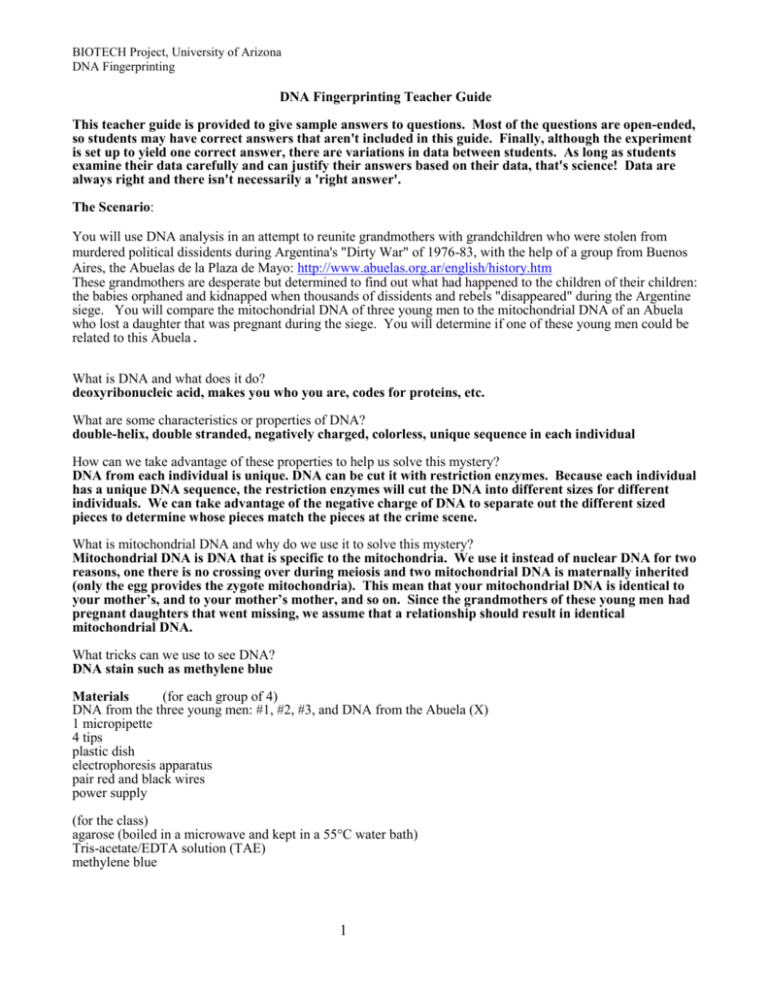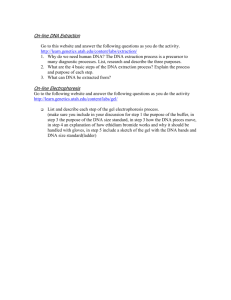Teacher Guide
advertisement

BIOTECH Project, University of Arizona DNA Fingerprinting DNA Fingerprinting Teacher Guide This teacher guide is provided to give sample answers to questions. Most of the questions are open-ended, so students may have correct answers that aren't included in this guide. Finally, although the experiment is set up to yield one correct answer, there are variations in data between students. As long as students examine their data carefully and can justify their answers based on their data, that's science! Data are always right and there isn't necessarily a 'right answer'. The Scenario: You will use DNA analysis in an attempt to reunite grandmothers with grandchildren who were stolen from murdered political dissidents during Argentina's "Dirty War" of 1976-83, with the help of a group from Buenos Aires, the Abuelas de la Plaza de Mayo: http://www.abuelas.org.ar/english/history.htm These grandmothers are desperate but determined to find out what had happened to the children of their children: the babies orphaned and kidnapped when thousands of dissidents and rebels "disappeared" during the Argentine siege. You will compare the mitochondrial DNA of three young men to the mitochondrial DNA of an Abuela who lost a daughter that was pregnant during the siege. You will determine if one of these young men could be related to this Abuela. What is DNA and what does it do? deoxyribonucleic acid, makes you who you are, codes for proteins, etc. What are some characteristics or properties of DNA? double-helix, double stranded, negatively charged, colorless, unique sequence in each individual How can we take advantage of these properties to help us solve this mystery? DNA from each individual is unique. DNA can be cut it with restriction enzymes. Because each individual has a unique DNA sequence, the restriction enzymes will cut the DNA into different sizes for different individuals. We can take advantage of the negative charge of DNA to separate out the different sized pieces to determine whose pieces match the pieces at the crime scene. What is mitochondrial DNA and why do we use it to solve this mystery? Mitochondrial DNA is DNA that is specific to the mitochondria. We use it instead of nuclear DNA for two reasons, one there is no crossing over during meiosis and two mitochondrial DNA is maternally inherited (only the egg provides the zygote mitochondria). This mean that your mitochondrial DNA is identical to your mother’s, and to your mother’s mother, and so on. Since the grandmothers of these young men had pregnant daughters that went missing, we assume that a relationship should result in identical mitochondrial DNA. What tricks can we use to see DNA? DNA stain such as methylene blue Materials (for each group of 4) DNA from the three young men: #1, #2, #3, and DNA from the Abuela (X) 1 micropipette 4 tips plastic dish electrophoresis apparatus pair red and black wires power supply (for the class) agarose (boiled in a microwave and kept in a 55°C water bath) Tris-acetate/EDTA solution (TAE) methylene blue 1 BIOTECH Project, University of Arizona DNA Fingerprinting Procedure: 1. Get your electrophoresis apparatus. Make sure the comb is in place near the BLACK ELECTRODE and that there are stoppers at both ends of the gel space. Why near the black electrode? DNA is negatively charged, so to move the DNA into the gel with electricity, the DNA needs to be loaded on the negative or black side, it will then move towards the red. If it's loaded near the red electrode, it will migrate off the gel into the TAE. 2. Pour hot agarose into the gel space until it reaches the top of the gel box. Let the agarose harden, which should take 5-10 minutes. Don’t touch/move your gel until it’s hard. Why not? If the agarose moves while it's hardening, it will harden unevenly, making it more difficult for the DNA to move through evenly. 3. Draw a picture of your gel and label which samples are where before you add DNA to the gel. The samples are indistinguishable once they are loaded, so everyone needs to have a drawing of what they will load where before they load their DNA samples. This drawing will be useful during the analysis, once the gels are stained. 4. Gently remove the stoppers and comb and load your DNA samples near the BLACK ELECTRODE. Be sure to keep track of which samples you loaded in which lanes. DNA is negatively charged, so to move the DNA into the gel with electricity, the DNA needs to be loaded on the negative or black side, it will then move towards the red. If it's loaded near the red electrode, it will migrate off the gel into the TAE. 5. Now gently pour TAE solution over your gel so that is it completely covered plus a little more. What do you think the TAE solution is for? TAE is like saltwater - it conducts electricity, plus it is a buffer to control f or pH changes 6. Run that gel!! Plug the electrodes into your gel box (red to red, black to black), being careful not to bump your gel too much. Plug the power source into an outlet. How can you tell your gel is running? It bubbles at the electrodes. This is a redox reaction, forming H2 gas at the black electrode and O2 gas at the positive electrode. Analyzing Your DNA Data Plug in your gel electrophoresis tray, and after 3 minutes draw another picture. 2 BIOTECH Project, University of Arizona DNA Fingerprinting The blue samples will move to the right (towards the positive red electrode) and separate into light blue and purple. They move to the positive electrode because they are negatively charged. They separate because they are different sizes, purple moves faster and farther because it is smaller (lower molecular weight). The DNA cannot be observed until the gel is stained because DNA is colorless. We add blue coloring to the DNA samples so you can see the samples as you are loading them. Once the purple dye has migrated approximately 2/3 of the gel, turn off the power and carefully remove the gel. The gel is very fragile, take care to not break it. You can remove the tray that you poured agarose on to and gently slide the gel into the staining tray. At this point you cannot see the DNA, what can you see and how do the four different lanes compare? The four lanes should all be the same. You should see two dyes in each lane, purple that migrated the furthest and a blue that is closer to the wells. The purples should have migrated the same distance from the wells, as the blues should have migrated the same distance from the wells. Once you have placed your gel into the staining tray bring it to the staining station. Completely cover the gel with methylene blue and cover try with saran wrap. Stain overnight. Next day--Viewing the gel: Pour the methylene blue back into the bottle and carefully place the gel onto a white light box. The gel is very fragile so take care to not break it. Draw a picture of your stained gel What can your data tell you about who committed the crime? Students should have an answer based on their data (e.g. I think it's #2 because the DNA pieces line up with Abuela’s DNA pieces; or The data aren't clear, we can't line up the crime scene DNA pieces with any of the individuals.) If you're dying to know whose DNA matches Abuela’s, it is #2. Feel free to NEVER tell your students the 'answer', they have to be confident about what their data show. Why use mitochondrial DNA and not nuclear DNA? We use it instead of nuclear DNA for two reasons, one there is no crossing over during meiosis and two mitochondrial DNA is maternally inherited (only the egg provides the zygote mitochondria). This mean that your mitochondrial DNA is identical to your mother’s, and to your mother’s mother, and so on. Since the grandmothers of these young men had pregnant daughters that went missing, we assume that a relationship should result in identical mitochondrial DNA. Recipes and Background Information • DNA samples For 10 reactions each: Sample #1 65 µl water 20 µl lambda DNA 10 µl buffer #3 5 µl EcoRI Sample #2 65 µl water 20 µl lambda DNA 10 µl buffer #2 5 µl PstI Sample #3 65 µl water 20 µl lambda DNA 10 µl buffer #2 5 µl HindIII Sample X 20 µl water 20 µl lambda DNA 5 µl buffer #2 5 µl PstI 20 µl water 20 µl lambda DNA 5 µl buffer #2 5 µl HindIII 3 BIOTECH Project, University of Arizona DNA Fingerprinting Incubate at 37°C for at least 2 hours, and up to 12 hours. For samples #1-3, add 20 µl 6X loading dye and pipet into 12 µl aliquots. For the 'X' sample, combine two reactions, add 20 µl 6X loading dye, and pipet into 12 µl aliquots. • 6X loading dye 6 ml 50% glycerol 1 ml 2% bromophenol blue 1 ml 2% xylene cyanol 2 ml distilled water • Tris-acetate-EDTA buffer for dye electrophoresis 10X stock (per liter) 48.4 g Tris base 11.4 ml glacial acetic acid 20 ml 0.5M EDTA (pH 8.0) Add distilled water to make total volume 1 liter. Dilute to make 1X working solution (100ml stock, 900 ml distilled water). • 0.8% Agarose gel for dye electrophoresis In 250 ml Pyrex bottle, combine: 125 ml 1X TAE 1 g agarose Microwave uncovered to melt agarose, be careful not to boil over on microwave or your hand. Cover loosely and store at room temperature. • 0.025% Methylene blue stain Make 1% methylene blue stock: 99 ml water and 1 g methylene blue powder. 10 ml 1% methylene blue stock 390 ml distilled water 4






